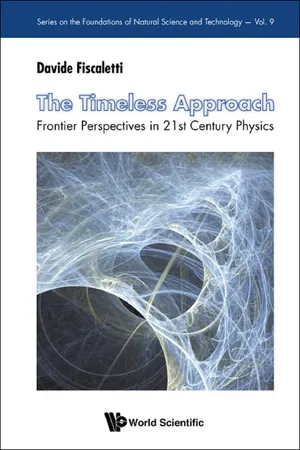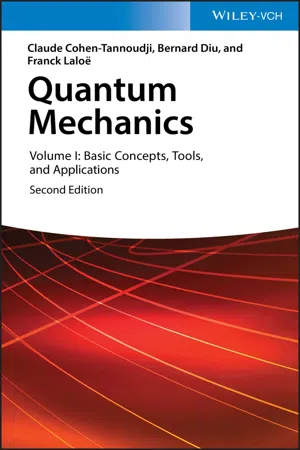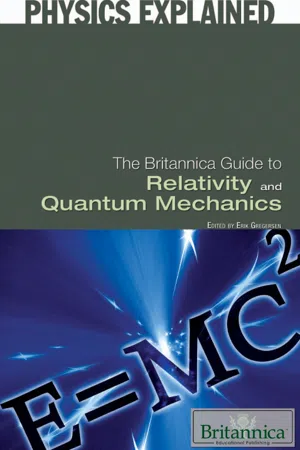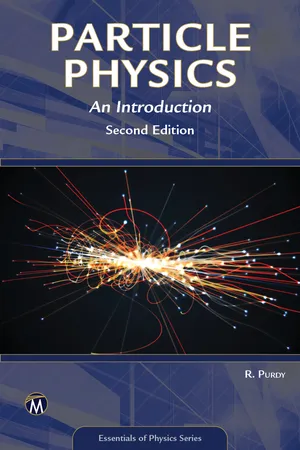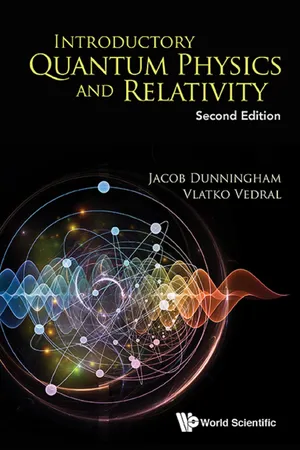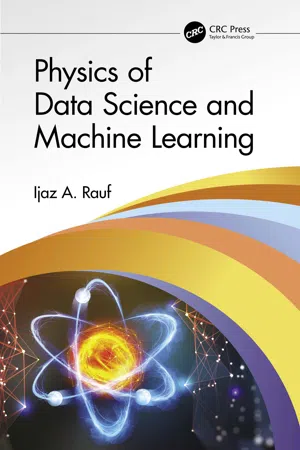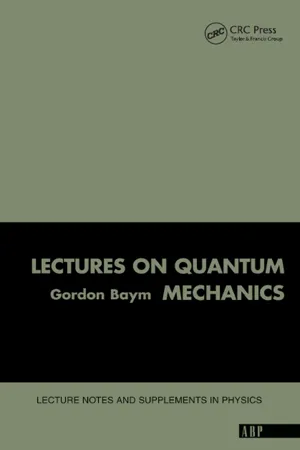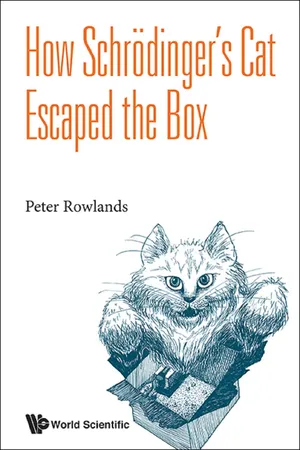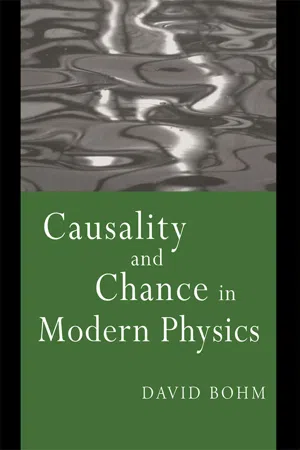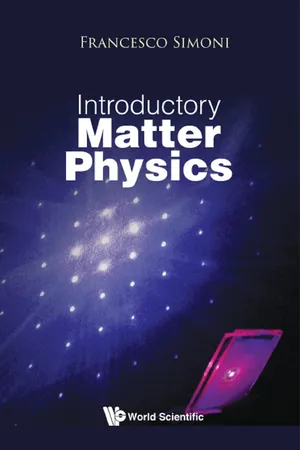Physics
Quantum Mechanics in Three Dimensions
Quantum mechanics in three dimensions refers to the application of quantum theory to systems in three-dimensional space. It involves the study of the behavior of particles and waves at the quantum level within a three-dimensional framework. This field of study is essential for understanding the behavior of atoms, molecules, and other fundamental particles in three-dimensional space.
Written by Perlego with AI-assistance
Related key terms
Related key terms
1 of 4
Related key terms
1 of 3
11 Key excerpts on "Quantum Mechanics in Three Dimensions"
- eBook - ePub
Timeless Approach, The: Frontier Perspectives In 21st Century Physics
Frontier Perspectives in 21st Century Physics
- Davide Fiscaletti(Author)
- 2015(Publication Date)
- WSPC(Publisher)
Chapter 3
Three-Dimensional non-Euclid Space as a Direct Information Medium and Quantum Phenomena
Quantum mechanics is not just a theory describing the behavior of microobjects: it is our current fundamental theory of motion. It can provide a deeper explanation and understanding of natural processes than classical mechanics. The empirical success of quantum mechanics is immense. Its physical obscurity is undeniable. The interpretation of what the quantum theory actually tells us about the physical world has raised a lively debate, which has continued from the early days of the theory to date. There are many interpretations of quantum mechanics described in some excellent books and articles. No consensus about which one is “valid”, if any, has been established so far. Indeed each interpretation seems to have its own merits and elucidates certain aspects of quantum mechanics.As is known, in quantum mechanics each physical system is described by a wave function. The wavefunction of an isolated microsystem evolves freely according to the Schrödinger evolution, that is certainly one of the most important equations of physics, as it allows us to understand the behavior of many materials and physical systems, such as for example semiconductors and lasers. Quantum mechanics was however originally formulated as a theory of quantum microsystems that interact with classical macrosystems. In the original formulation of the theory (known as Copenhagen interpretation or standard interpretation), the interaction of a quantum microsystem S with a classical macrosystem O is described in terms of “quantum measurements” [151 , 152 ]. Once the microsystem S under consideration interacts with its surroundings, they become entangled and they are in a quantum mechanical superposition. If the macrosystem O interacts with the variable q of the microsystem S , and S is in a superposition of states of different values of q , then the macrosystem O measures only one of the values of q , and the interaction modifies the state of S - eBook - ePub
Quantum Mechanics, Volume 1
Basic Concepts, Tools, and Applications
- Claude Cohen-Tannoudji, Bernard Diu, Franck Laloë(Authors)
- 2020(Publication Date)
- Wiley-VCH(Publisher)
Chapter I Waves and particles. Introduction to the fundamental ideas of quantum mechanics- A Electromagnetic waves and photons
- A-1 Light quanta and the Planck-Einstein relations
- A-2 Wave-particle duality
- A-3 The principle of spectral decomposition
- B Material particles and matter waves
- B-1 The de Broglie relations
- B-2 Wave functions. Schrödinger equation
- C Quantum description of a particle. Wave packets
- C-1 Free particle
- C-2 Form of the wave packet at a given time
- C-3 Heisenberg relations
- C-4 Time evolution of a free wave packet
- D Particle in a time-independent scalar potential
- D-1 Separation of variables. Stationary states
- D-2 One-dimensional “square” potentials. Qualitative study
In the present state of scientific knowledge, quantum mechanics plays a fundamental role in the description and understanding of natural phenomena. In fact, phenomena that occur on a very small (atomic or subatomic) scale cannot be explained outside the framework of quantum physics. For example, the existence and the properties of atoms, the chemical bond and the propagation of an electron in a crystal cannot be understood in terms of classical mechanics. Even when we are concerned only with macroscopic physical objects (that is, whose dimensions are comparable to those encountered in everyday life), it is necessary, in principle, to begin by studying the behavior of their various constituent atoms, ions, electrons, in order to arrive at a complete scientific description. Actually, there are many phenomena that reveal, on a macroscopic scale, the quantum behaviour of nature. It is in this sense that it can be said that quantum mechanics is the basis of our present understanding of all natural phenomena, including those traditionally treated in chemistry, biology, etc...From a historical point of view, quantum ideas contributed to a remarkable unification of the concepts of fundamental physics by treating material particles and radiation on the same footing. At the end of the nineteenth century, people distinguished between two entities in physical phenomena: matter and radiation. Completely different laws were used for each one. To predict the motion of material bodies, the laws of Newtonian mechanics (cf. Appendix III) were utilized. Their success, though of long standing, was none the less impressive. With regard to radiation, the theory of electromagnetism, thanks to the introduction of Maxwell’s equations, had produced a unified interpretation of a set of phenomena which had previously been considered as belonging to different domains: electricity, magnetism and optics. In particular, the electromagnetic theory of radiation had been spectacularly confirmed experimentally by the discovery of Hertzian waves. Finally, interactions between radiation and matter - Britannica Educational Publishing, Erik Gregersen(Authors)
- 2010(Publication Date)
- Britannica Educational Publishing(Publisher)
CHAPTER 3 QUANTUM MECHANICS : CONCEPTSQ uantum mechanics is the science dealing with the behaviour of matter and light on the atomic and subatomic scale. It attempts to describe and account for the properties of molecules and atoms and their constituents—electrons, protons, neutrons, and other more esoteric particles such as quarks and gluons. These properties include the interactions of the particles with one another and with electromagnetic radiation (i.e., light, X-rays, and gamma rays).HISTORICAL BASIS OF QUANTUM THEORY
At a fundamental level, both radiation and matter have characteristics of particles and waves. The gradual recognition by scientists that radiation has particle-like properties and that matter has wavelike properties provided the impetus for the development of quantum mechanics. Influenced by Newton, most physicists of the 18th century believed that light consisted of particles, which they called corpuscles. From about 1800, evidence began to accumulate for a wave theory of light. At about this time Thomas Young showed that, if monochromatic light passes through a pair of slits, the two emerging beams interfere, so that a fringe pattern of alternately bright and dark bands appears on a screen. The bands are readily explained by a wave theory of light. According to the theory, a bright band is produced when the crests (and troughs) of the waves from the two slits arrive together at the screen; a dark band is produced when the crest of one wave arrives at the same time as the trough of the other, and the effects of the two light beams cancel. Beginning in 1815, a series of experiments by Augustin-Jean Fresnel of France and others showed that, when a parallel beam of light passes through a single slit, the emerging beam is no longer parallel but starts to diverge; this phenomenon is known as diffraction. Given the wavelength of the light and the geometry of the apparatus (i.e., the separation and widths of the slits and the distance from the slits to the screen), one can use the wave theory to calculate the expected pattern in each case; the theory agrees precisely with the experimental data.- eBook - ePub
Particle Physics
An Introduction
- Robert Purdy(Author)
- 2022(Publication Date)
- Mercury Learning and Information(Publisher)
3QUANTUM MECHANICSWhile special relativity given our understanding of space and time a gentle prod in the right direction, quantum mechanics beat our ideas of the universe into submission. We will not delve into the history or origins of quantum mechanics, as other texts do a better job of this than a single chapter can manage. As in the last chapter, the aim here is to provide a reminder of some ideas that the reader should be familiar with, focusing in particular on those points that are most relevant to later chapters. For a comprehensive introduction to the subject, the reader is directed to the quantum mechanics text in this series: The Nuts and Bolts of Quantum Mechanics .3.1. STATES AND OPERATORSA good place to start in understanding quantum mechanics is the wave-particle duality: particles exhibit wave-like behavior and waves can sometimes act like particles. This is very counter-intuitive since waves and particles are very different beasts on the surface. Waves are characterized by smooth continuous properties whereas particles are discrete objects with definite properties. The way to make (at least some) sense of this duality is to understand that everything acts in a manner that is not quite like either of these concepts but as something that has properties of both. There is a correspondence between the particle-like and the wave-like properties of a quantum object, that can be summed up in two equations. First, the energy of a particle is related to the angular frequency of its corresponding wave by E = ω , and second, the momentum of a particle is related to the wave vector by p = k . As with relativity, we take the hint that nature is giving us, and re-define our units in such a way as to get rid of the unnecessary constants. In particular, we choose = 1, reducing these equations to E = ω and p = k. - eBook - ePub
- Jacob Dunningham, Vlatko Vedral(Authors)
- 2018(Publication Date)
- WSPC(Publisher)
Chapter 3
Quantum Mechanics
We now describe the full theory of quantum mechanics which emerged in the 1920s. There are four rules of quantum mechanics, and they fully describe anything that we would like to calculate. These ideas will seem strange at first and it will probably take you a while to feel comfortable with them. Bohr himself said that “those who are not shocked when they first come across quantum mechanics cannot possibly have understood it.” It is, however, well worth the effort.The rules are: 1.States of physical systems are represented by complex functions, called wave functions. 2.Observables of physical systems, that is, things that we can measure, such as the position or momentum of a particle, are represented by Hermitian operators. 3.When we make a measurement of the system, we probabilistically obtain the answer according to the modulus square of the wave function. This is the so-called Born measurement postulate. 4.The system, when not measured, evolves according to the Schrödinger equation.The meaning of each of these statements will become clear as we start to develop the ideas of quantum mechanics. Suffice it to say that the statements are neither intuitively clear nor physically motivated at this stage.1 The ultimate justification, as always for a physicist, is that these rules are in extremely good agreement with experimental results and tests. Quantum mechanics is, by far, our most accurate description of nature. With that in mind, let us proceed. First we will discuss the Schrödinger equation that appears in the fourth rule, which was, in fact, discovered well before the other postulates of quantum mechanics were phrased.3.1.Schrödinger’s equation
If particles are waves, it would seem reasonable to expect to be able to write a wave equation for these quantum objects.2 So we need to understand how waves behave in the first place.Waves were already well understood by physicists in the 19th century. A wave equation is usually an equation that involves a second derivative in both space as well as in time. It reads something like - eBook - ePub
- Ijaz A. Rauf(Author)
- 2021(Publication Date)
- CRC Press(Publisher)
y1 is a great deal of kinetic energy. It is all about this energy frozen into one state. The particle has no other energy state to “play in” in the y-direction. If the pipe in the z-direction is also extremely short, the only essential and relevant motion is in the x-direction making nontrivial physics completely one-dimensional. We have produced a “quantum wire.”However, suppose the pipe size in the z-direction is relatively large. In that case, the particle will still have lots of different energy states available in the z-direction, and the motion will be two-dimensional, a “quantum well.” On the other hand, if the pipe is small in all three dimensions, we get a zero-dimensional “quantum dot” in which the particle does little until it absorbs a significant amount of energy. It will give readers a rough understanding of all the fascinating things one can do in nanotechnology when one restricts particle movement, mainly electrons, in different directions. One is turning the dimensionality of our standard three-dimensional universe into a lower one. Only quantum mechanics can explain why by making the energy levels discrete rather than continually varying. Moreover, the smaller dimensions’ cosmos will have one’s topology preference (a triangle, a letter 8, a circle, a cylinder) to make it very interesting.3.2 Dynamics of Quantum Mechanical Systems
Let us consider the example of a particle bound by forces to stay in virtually the same position. It may be defined as objects such as an atom or a molecule in a crystalline solid. Suppose the forces driving the particle back to its nominal location are proportional to the displacement and are directed toward the particle equilibrium location. In that case, we have what is called a harmonic oscillator. This relationship is generally a reasonable approximation for other restricted systems if the distance from the nominal position remains high. We will show the particle’s displacement from the nominal position (x, y, z). It is possible to model the forces which hold the particle confined as springs, as sketched in Figure 3.6 - eBook - ePub
- Gordon Baym(Author)
- 2018(Publication Date)
- CRC Press(Publisher)
Chapter 3 THE MOTION OF PARTICLES IN QUANTUM MECHANICSThe motion of a particle in quantum mechanics is described by a (complex) wave function, ψ(r, t), that gives the probability amplitude for finding the particle at point r at time t. The absolute value squared |ψ(r, t)|2 of the wave function times a volume element d3 r is the probability of finding the particle at time t in the volume element d3 r about t. Because the wave ψ(r, t) is a probability amplitude, it doesn’t tell us how any one particle will behave, but rather it tells us the behavior of a large statistical sample of particles subjected to identical conditions. We found the same situation in discussing the polarization state of the photon; we could not say with certainty how any one photon would behave when, for example, passed through a polaroid. We could only give the fraction of a large number of identical photons that passed through the polaroid, and hence only the probability that any one would pass through.THE SCHRÖDINGER EQUATION 1Suppose that we know the wave function for a particle at a certain time t. How will it change over the course of time? Let us begin by answering this question for a particle that moves in one dimension only. It will be most convenient for us to divide the line along which the particle moves into very small intervals, each of length λ (Fig. 3-1 ). We label the intervals by letters, i, j,…, and let ψi (t) be the probability amplitude for finding the particle in the interval i at time t. Then |ψi (t)|2 is the probability of finding the particle in the interval i at time ti and since the particle must be somewhere along the line, the total probability, summed over all the intervals must be one,Fig. 3-1 - eBook - ePub
The Language of Modern Physics
An Introduction to the Philosophy of Science
- Ernest H. Hutten(Author)
- 2022(Publication Date)
- Routledge(Publisher)
Let us add that the mathematical part of the theory may be given also by still other kinds of formalism; and, in general, for a limited part of quantum mechanics almost any kind of mathematics has been used, at one time or another. True that, on occasion, this has been done only for heuristic reasons to facilitate computation. Since the mathematical equations of a theory are certainly a part of the formal calculus, we must agree that there is a good deal of choice as far as some syntactic rules are concerned. Of course, the rules of mathematics are not the only syntactic rules we have in the system; there must also be rules governing the use of the word symbols. Finally, we must add that the relativistic formulation of quantum theory as given by Dirac represents still another semantic system, since it involves a different sort of mathematics—transformation theory—as well as a somewhat modified interpretation. However, it suffices here to restrict ourselves to the discussion of the original wave and particle interpretations in order to see the logical construction of modern theory.In quantum mechanics, then, we have two possible interpretations, and each of these equivalent descriptions alone can account for all the observable results. In practice, however, we need both of them : it would be most inconvenient if we were to retain only one of these interpretations. For we are accustomed from classical physics to describe certain phenomena by the wave concept, and others by the particle concept.Every experiment consists of several, causally connected, happenings. If a beam of electrons is sent against a diffracting slit, we describe the happenings at the slit in terms of waves. Indeed, in classical optics, the diffraction phenomenon has been taken as the crucial experiment demonstrating that light consists of waves. But the electrons are shot from an ‘electron gun’; they are emitted from a heated filament, and this process, as well as the focussing of the beam by electric and magnetic fields is more naturally described by the particle concept. After the electrons have passed the slit, we may again describe the happenings on the screen in these two ways. The flashes of light we see when an electron impinges upon the screen—particularly at low intensity—obviously call for a particle interpretation. The over-all distribution of maxima and minima—of illumination and shadow—is more naturally described by a wave pattern.But in quantum mechanics there is a definite rule prescribing the correct usage of the two interpretations. As Bohr has formulated it, we are forced ‘to adopt a new mode of description designated as complementary in the sense that any given application of classical concepts precludes the simultaneous use of other classical concepts which in a different connection are equally necessary for the elucidation of the phenomena’. Once we have decided to describe a certain event in terms of the wave concept, we cannot at the same time make use of the particle concept for the same purpose. If we mix these two interpretations, we get into difficulties. These difficulties are of an intriguing kind ; they are due, in the last resort, to the rules inherent in the language we are accustomed to use. The principle of complementarity, then, states that we have two interpretations on the basis of two different key-concepts. - eBook - ePub
- Peter Rowlands(Author)
- 2014(Publication Date)
- WSPC(Publisher)
In the first place, most treatments of quantum mechanics package all the information available about a system into an object called the wavefunction (usually symbolised by ψ), which acts as a kind of black box. We do operations on it and get experimentally testable results for particular conditions, but what it is is never properly specified — we have no way of knowing what is in the box. We know that the wavefunction has wavelike features such as ‘amplitude’ and ‘phase’, and that quantum mechanical equations are in some ways similar to the ordinary wave equations generated by classical physics, but the quantum mechanical wavefunction is most definitely not a description of an ordinary wave. In addition, the more advanced forms of quantum mechanics, such as relativistic quantum mechanics and quantum field theory, tend to introduce seemingly arbitrary mathematical complications, such as matrices, which destroy the elegance and symmetry that we have come to expect of supposedly fundamental physics. The methods are old and well established and they yield good results, so we have developed a kind of ‘recipe book’ for quantum calculations which is exactly what we teach as quantum mechanics to our students. There are lots of things to calculate, so we haven’t got the time to work out what is going on. A few people worry about the foundations of the subject, but that kind of thing can be left to the philosophers. Although some of the founders of quantum mechanics — including Bohr, Heisenberg and Schrödinger — were deeply interested in philosophy and even influenced by it, the kind of education they received is not common nowadays, and partly due to their efforts, there is far more physics for a student to absorb than there would have been in 1925 - eBook - ePub
- David Bohm(Author)
- 2004(Publication Date)
- Routledge(Publisher)
CHAPTER THREE: The Quantum Theory
1. INTRODUCTION
IN the previous chapter we have given a discussion on the evolution of classical physics, starting with Newton’s laws of motion, and continuing on to all the new developments which occurred up to the end of the nineteenth century. Throughout this time, however, the general philosophical view held by physicists was that of deterministic mechanism. For it was felt that even though the details of the theories that were then current would eventually have to undergo various modifications in response to the results of further experiments, the basic general scheme in which all theories are formulated in terms of differential equations determining the future behaviour of everything in the universe completely in terms of their states at a given instant of time would never have to be changed. For example, Lord Kelvin, one of the leading physicists of the time, expressed the opinion that the basic general outline of physical theories was pretty well settled, and that there remained only “two small clouds” on the horizon, namely, the negative results of the Michelson-Morley experiment and the failure of Rayleigh-Jeans law to predict the distribution of radiant energy in a black body. It must be admitted that Lord Kelvin knew how to choose his “clouds”, since these were precisely the two problems that eventually led to the revolutionary changes in the conceptual structure of physics that occurred in the twentieth century in connection with the theory of relativity and the quantum theory.Now, while the theory of relativity brought about important modifications in the specific forms in which the causal laws are expressed in physics, it did not go outside the previously existing theoretical scheme, in which the values of suitable parameters at a given instant of time would in principle determine the future behaviour of the universe for all time. We shall, therefore, not discuss the theory of relativity in this book, in which we are interested primarily in the question of causality, because this theory raised no question that went to the root of the problem of causality. - eBook - ePub
- Francesco Simoni(Author)
- 2018(Publication Date)
- WSPC(Publisher)
A to fix the specific wave function describing the particle.It is necessary that Eq. (2.62) is fulfilled by a solution to the Schrödinger equation, in order to represent the particle dynamics. For this reason, one says that the possible states are given by the square-integrable solutions.In this context, it is very relevant that Schrödinger equation allows holding the normalization condition with time: if a wave function is normalized at t = 0, it holds the normalization at any time. In one dimension it means thatDemonstration is straightforward: On the other hand,This result can be easily extended to the more general threedimensional case.Then we write the Schrödinger equation for ψ and for ψ∗ :Therefore,Since ψ and ψ∗ must vanish when x → ±∞ (otherwise they could not be normalized),2.4. Physical quantities, operators and expectation values
In the previous section, we have introduced the Hamiltonian operator ≡ + (r, t), associating it with the total energy. It is actually a general procedure in quantum mechanics to have a correspondence between physical quantities and operators. Starting from the kinetic energy operator, we can easily find a way to get other operators. In fact, since we can write the kinetic energy as we can associate the operator with the momentum p, with ∇ being the gradient operator:In this way, we correctly get Then we have the associationas the momentum operator andas the angular momentum operator.One basic assumption of quantum mechanics is that each dynamical quantity related to the motion of the particle can be represented by a linear operator.5
Index pages curate the most relevant extracts from our library of academic textbooks. They’ve been created using an in-house natural language model (NLM), each adding context and meaning to key research topics.
Explore more topic indexes
Explore more topic indexes
1 of 6
Explore more topic indexes
1 of 4
